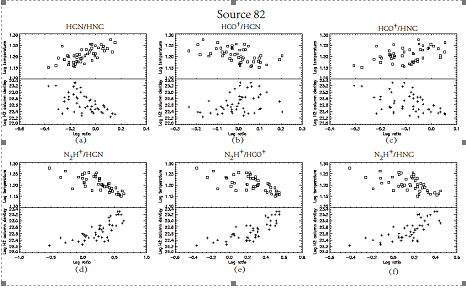Many authors have used molecular lines at millimeter such as N2H+(1–0), HCO+(1–0), HCN(1–0), HNC(1–0) an CN(1-0) to study the evolution of massive star forming regions, and try to find a chemical clock for massive star formation. However, these studies did not always give consistent results. One possible reason may be that there exists obvious spatial variations of the chemical properties in massive star forming regions.
Researchers in the star formation and evolution Group selected 90 massive star-forming clumps with strong N2H+(1–0), HCO+(1–0), HCN(1–0), and HNC(1–0) emission from the Millimetre Astronomy Legacy Team 90 GHz survey. They obtained Herschel data for all 90 sources and NRAO VLA Sky Survey data for 51 of them. They convolved and regridded all images to the same resolution and pixel size and derived the temperature, H2 column density, molecules’ abundances and ratios of each pixel.
Their analysis yields three main conclusions. First, the abundances of N2H+, HCO+, HCN, and HNC increase when the H2 column density decreases and the temperature increases, with spatial variations in their abundances dominated by changes in the H2 column density. Second, the abundance ratios between N2H+, HCO+, HCN, and HNC also display systemic variations as a function of the column density due to the chemical properties of these molecules. Third, the sources associated with the 20 cm continuum emission can be classified into four types based on the behavior of the abundances of the four molecules considered here as a function of this emission. The variations of the first three types could also be attributed to the variation of the H2 column density.

Source 82, one example of our star forming clumps, shows variations of the abundance ratios with temperature and H2 column density.
Paper link: https://iopscience.iop.org/article/10.3847/1538-4365/ab2465